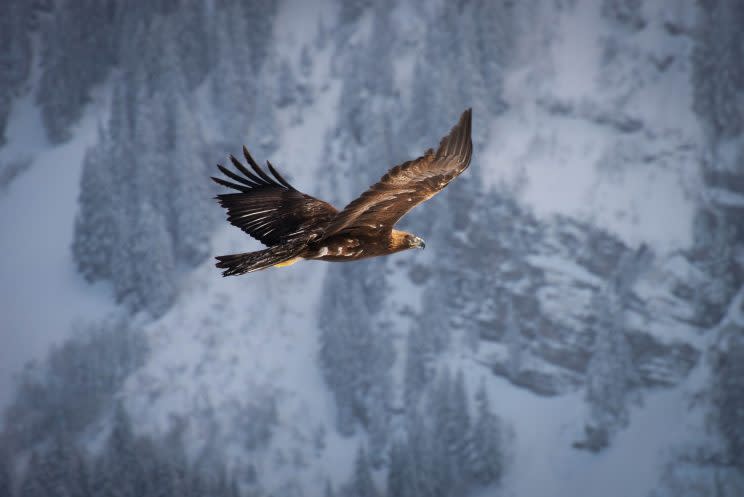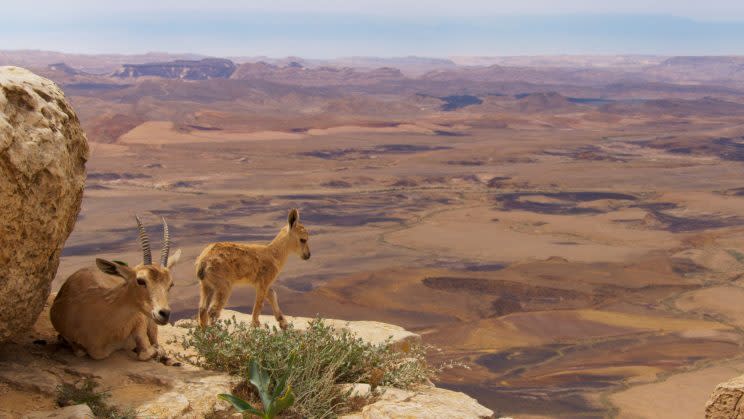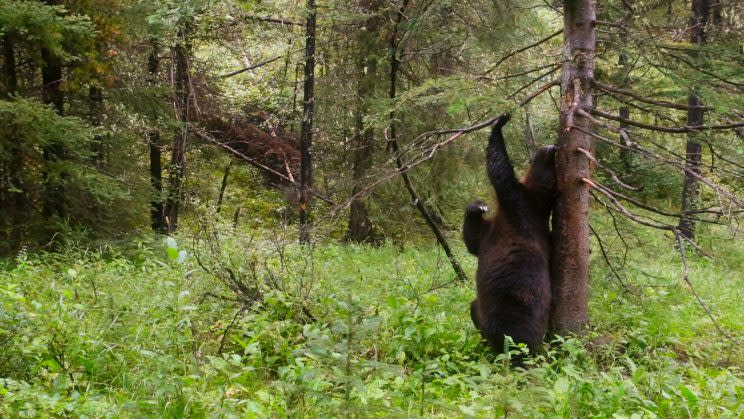‘Planet Earth II’ Producers Preview Must-Watch ‘Mountains’ Moments
After premiering with “Islands,” Planet Earth II returns Saturday night on BBC America with a breathtaking “Mountains” episode. “That show was a very, very interesting one because mountains are quite unemotional places in some ways. They’re quite austere. They’re quite stark. They’re quite magnificent,” series executive producer Mike Gunton tells Yahoo TV. “What I think Justin Anderson [producer/director of the “Mountains” hour] did there was really draw something quite visceral out of it. Everyone has their favorites, but there’s something about the scale and the awe of that show that I absolutely love.”
Gunton and Anderson spoke to Yahoo TV to preview some of the episode’s highlights.
Snow leopards in the Himalayas (Ladakh, India)
With as few as 3,500 snow leopards remaining in the wild, it’s always a privilege to see one. The first time Anderson spotted one from a half a kilometer away, he did a dance on the spot. “The local guides there say, ‘When you see a snow leopard, it’s like your soul is singing’ or ‘your soul is flying,’ and it really does sum up what it feels like,” he says. “There’s a guide who must have seen 300 or 400 snow leopards in his time, and still, every time he sees one, his face is like a little boy’s — he’s just so happy. It’s one of those animals that really awakens the emotional side of us.”
The sequence is a favorite of Gunton’s because it showcases why you do a sequel to a benchmark nature series like Planet Earth: Ten years ago, snow leopards were filmed from a lens nearly a mile away. Now, technology has advanced to the point that the crew was able to place remote cameras right along the trails and scenting rocks used by the elusive animals (solitary snow leopards rub particular rocks with their cheeks and then spray urine on them, leaving “pee-mail” so they know who else has traveled by). “We’ve had types of remote cameras,” Gunton says, “but the quality, the reliability, the self-powering of them, the way that we can get them to be switched on is a really interesting breakthrough,” he says. “That piece of technology gives you something that is utterly unique. Ultimately the goal is to reveal, isn’t it? Of course we want you to get emotionally engaged. We want you to be moved. We want you to be maybe even stimulated to do something. But ultimately, the primary goal of what we do is revelation — showing how the natural world operates, how the animals live, what their lives are like. Technology that allows you to reveal new things, that’s my and our driver.”
Anderson says it took engineers six months to build the cameras that could withstand those extreme conditions and demands in the Himalayas. The production returned three springs in a row to film the cats, which allowed Anderson’s team to build on the knowledge of the local guides who knew their movements. “After the first year, we figured out where they like to place their paws, so we were able to get more and more ambitious with our framing and where we position our cameras and get close-ups that no one would have been ambitious enough to do before,” Anderson says.

The crew was on location for a total of roughly 16 weeks, but the cameras stayed longer. “On the first shoot, we got a couple of shots from the camera traps whilst I was on location and I was able to take them back with me. They were amazing to see because you’d spend a day setting up a camera somewhere, so you’d get to know the location really intimately, and then you’d sit in your tent and see this snow leopard walk through the same scenario where you’d just spent all this time, and you would feel this real connection to them, even though you’re separated by time and distance,” Anderson says. “Obviously we kept the cameras in use long after our crew had returned from the field, and we used a couple of local guides who work in the national park, and they really put in the hard work: every couple of weeks, they’d be hiking up the trails, going to all the cameras changing batteries, changing memory cards. I would get these envelopes from India covered in stamps, and I would go through all these cards, and a lot of times we’d have these false triggers, where it would be the wind or the snow falling that triggered the cameras. But just every now and then, we would get snow leopards, and every single time it just felt like the most incredible thing to see. I never got tired of seeing them walk in and out of the shots. We got so many shots in the end, it was unbelievable. We couldn’t use them all.”
The crescendo of the snow leopard sequence in “Mountains” is when an adult female snow leopard, who’s still traveling with her 2-year-old cub, goes into heat again. Her scent and mating call, which can be heard from miles around, put her cub at risk — adult males kill cubs that are not their own. When two males arrive, the mother and cub are caught between them, and the mother has to divert the males’ attention so her cub can sneak away. It’s the first time four snow leopards have been filmed at once.
The sequence was actually filmed the first year, Anderson says. He’d left the location a week earlier to go shoot another sequence in Nepal, and when he returned, the cameramen wouldn’t tell him what they’d captured. “They just said, ‘You’ve got to see it. You’ve got to see it.’ I’m imagining all these things they might have filmed and why they wouldn’t tell me. When I saw it … it was just completely unprecedented and beyond anything that we could have expected,” he says. “It’s behavior that is so new [on film] even the snow leopard experts were kind of scratching their heads as to what was going on. There was a lot of trying to interpret what was happening there, and we worked very hard to get that right.”
One of the males refuses to leave the mother alone, so she can return to her cub, until he mates with her — something viewers learn from narrator Sir David Attenborough rather than witnessing. After the U.K. airing of the episode, some shocked viewers used the term “snow leopard rape.” That surprised both Gunton and Anderson. “These are wild animals, and I think using the description of a human criminal behavior for that story is wrong on a number of levels,” Anderson says.
Snow leopards meet so infrequently that there is always tension. The mother snow leopard is injured, and without spoiling how the mother-daughter journey ends, Gunton admits he’s cried watching it. “Getting the camera so close to the animals, I think, has just amplified that sense of connection,” he says. “I knew the story, and I’ve seen it a thousand times, but when I finally saw it all together with Hans Zimmer’s music and the sound of David Attenborough’s voice … it’s very, very powerful.”
Golden eagles in the French Alps
In the March 25 “Making of Planet Earth II” episode, viewers will see how a cameraman sat in a “hide” (or a blind, as we call the lookouts in America) to capture footage of golden eagles fighting over the carcass of a dead fox. But “Mountains” is special for its sequence of the birds in flight.
When Anderson was in India filming the snow leopards, he saw golden eagles in the Himalayas. “They would buzz down this canyon at really high speeds, and it would sound just like a fighter jet going over,” he says. “They’re obviously a bird that is quite iconic of the high mountains, and I started to think about what it would it be like for our viewers to share that experience, to see it through the bird’s eyes, if we could imagine what it’s like to be flying through the high mountains and then suddenly dive down as fast as you could hugging the slope.”

In addition to using a helicopter to film the wild birds, which can dive at over 185 mph, an understandably nervous cameraman ended up tandem-paragliding with a world speed-racer champion to simulate that feeling (something also covered in the “making of” hour). The crew also worked with Jacques-Olivier Travers, a raptor conservationist who trains eagles with the hope of returning them to fly in the wild, to place a miniature 4K camera on the back of a young golden eagle named Slovak. The actual bird’s-eye view is so stunning, your eyes may get misty, but again, some U.K. viewers were surprised that a trained animal was used.
“You can’t put cameras on wild animals because it’s unethical, and also, how the hell would you get the camera back?” Gunton says. In his eyes, placing a camera on an animal is often just a gimmick. However, “The camera on the back of the eagle was done for a very specific purpose in that we wanted to give a sense of what it was really like to fly like an eagle,” he says. “We all discussed it, and we thought this was maybe the one case when it was legitimate to try it. … The reaction was mixed. I think people were confused. I don’t think there’s anything wrong with it ethically. But I think it probably did muddy the waters in a way that, perhaps, if I were doing it again, I might have rethought.”

Nubian ibex (Israel)
They live in the desert mountains of the Arabian Peninsula up to altitudes of 8,500 feet. The nursery slopes keep the young ibex safe from predators — but then they have to descend 300 meters to drink water, which is when they’re vulnerable to red foxes. “We feel quite nervous for them, but actually, they are just the most amazing athletes and just incredible at what they do,” Anderson says. “That was another tough shoot because the crew that was tracking the ibex were struggling to keep up with them because they move so fast and so far. We had two trips for that shoot, and I think the majority of the sequence is from the second time around when the crew had worked out where they might be in any given place.”
Flamingos in the Andes (San Pedro de Atacama, Chile)
Imagine a lake some 13,000 feet high in the Andes that freezes at night. Now imagine flamingos — which gather there to breed after first performing a mysterious parade dance (“There’s just something both beautiful and ridiculous about it,” Gunton says) — getting their legs stuck in it.
“We woke up one morning, having spent a very, very cold night sleeping in the car, and there were the flamingos just breaking out of the ice,” Anderson says. “We’d hoped to film that behavior. We knew that the sun would free them. But what we didn’t realize was the amount of slipping around, falling through the ice, and the sheer slapstick that we’d get through the behavior. ”

Grizzly bears in the Rockies (Alberta, Canada)
When grizzly bears emerge from hibernation in Alberta, their winter coat has to go. “I think the bears scratching their backs on those trees when they come down is just pure comedy,” Gunton says. “You don’t have to say a word. It’s just hilarious.” The footage, from remote camera traps concealed in the rubbing trees, is perfectly scored by Zimmer and his team. “Comedy is the hardest of all to get right. The danger is, you go, [hums circus theme]. But sometimes, a sort of obvious, almost cliché music is even funnier. I think they got it pretty well spot-on,” Gunton says. “When we were messing around in the office, we always had it playing to ‘Jungle Boogie,’ which was great.”
For Anderson, it was just a question of finding the trees the bears really loved to visit and hoping that the camera technology worked. “For the bears, we used a different type of camera trap. Our concern was that a load of cables running through the forest, either the bears would find them and snag them or we’d get lots of rodents chewing through them, which isn’t a problem when you’re up in the mountains — with snow leopards there’s nothing else around,” he says. “So we needed to have these wireless trigger ones, and that led to lots of challenges. It was probably a four-month shoot for the camera traps there, and again, we had local volunteers going out swapping the cards, swapping the batteries, and sending us back the footage. Those shots started to slowly come in, and we thought, ‘This is gonna be hilarious.’ It was a real surprise to everyone.”

Bobcats in Yellowstone National Park
Wild bobcats are seldom spotted by humans, and the sequence of them hunting in a snow-covered Yellowstone is some of the most intimate footage of them ever recorded. “I know my colleague, John Shier, who lives in Montana, worked very hard on that shoot — skiing through the snow, getting close to the bobcats in freezing cold conditions,” Anderson says. “I think it’s a really beautiful story, and it’s nice that it’s an American story as well.”
Planet Earth II airs Saturdays at 9 p.m. on BBC America.
Read more:
Ken Tucker on What’s Next for ‘Nashville’
‘Big Little Lies’ Star Zoe Kravitz Admits it’s ‘Annoying’ How Nice Her Character Is
Oscars: What Jimmy Kimmel’s Past Hosting Gigs Tell Us About What to Expect

